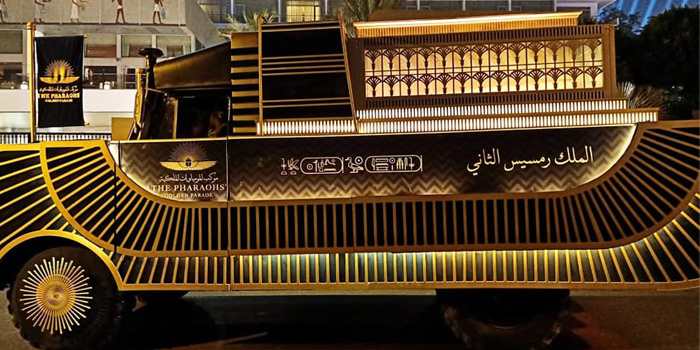

Mummies of Kings and Queens are prepared to be transported on the 3rd of April, from the Egyptian Museum, Tahrir, downtown Cairo, to the National Museum of Egyptian Civilization (NMEC), in Fustat, Old Cairo.
It's planned to go with the traditional way of Pharaohs; chariots and horses will be carrying 22 King and Queen through a legendary procession. The Royal parade includes 18 Kings and 4 Queens mummies along with 17 Royal Sarcophagi from the 17th to 20th dynasties.
The NMEC is a museum in Fustat, the old capital of Egypt, overlooking the Ain Al-Sira Lake, in Old Cairo near the old mosque of Amr Ibn Al-Aas, the hanging church, and Ben Ezra Synagogue. The museum is the first of its kind in the Arab World; it will present the Egyptian Civilization from prehistory to the present day. The NMEC was being prepared and equipped from years ago to welcome the royal mummies in its halls.
She was the first woman to rule Egypt and maybe the first woman to head a nation through all mankind's history.
She was the fifth Pharaoh of the 18th dynasty, took over the throne in 1478 BC, and died in 1458 BC.
Or Ramses The Great as he was widely known. During his reign, Egypt was an empire; he ruled for almost seven decades until he died in 1213 BC. He was the first ruler in history to hold a peace treaty. He was the third Pharaoh of the 19th dynasty.
Another emperor, was also constantly expanding the Egyptian territory after he fought his stepmother Hatshepsut and took over the throne. He ruled for almost 54 years until he died in 1425 BC.
The father of King Ramses II and the first Pharaoh of the 19th dynasty. His main purpose was to control the country after years of chaos. He ruled from 1290 to 1279 BC.
She was King Ahmose I's wife, the first Pharaoh of the 18th dynasty who was the origin of the New Kingdom.
Also, the procession will include:
Seqenenre Tao – Thutmose I – Amenhotep I – Thutmose II – Amenhotep II – Thutmose IV – Amenhotep III –Mernptah – Seti II – Siptah – Ramses IV – Ramses V – Ramses IX
The path will be decorated with Pharaonic inscriptions by Egyptian fine arts students, including any wall or building on the track, launching from Tahrir Square, which was already decorated by a giant obelisk surrounded by rams.
From its side, the Ministry of Tourism and Antiquities has set up some precautions to guarantee the Mummies safety during transportation.
A report had been made for each mummy, declaring its condition and mentioning the mummy's history and if it had been restored before or not.
Also, Dr. Zahi Hawas had examined all these mummies through a CT scan and a DNA test to give a final accurate report about their conditions and confirm their identity.
Many measures will be taken to keep a moderate temperature inside each mummy box during the transport.
Anti-vibration materials will also be put to keep the mummies safe until they reach their final destination at the National Museum of Egyptian Civilization.
The transportation process will be responsible for a company affiliated with the armed forces; the vehicle should not exceed a certain speed of 30 Km/H.
This festival is meant to take you back in time, to simulate the royal parade, which was used to be held to honor the Kings.
"Don't miss this unrivaled, once-in-a-lifetime event. Stay tuned for The Pharoahs' Golden Parade on the 3rd of April 2021," the ministry said in its promo video for the awaiting event.
A Nile River cruise in Egypt is a journey through time, allowing you to explore this historic... [Read More]
The History of Ancient Egyptian Mummies is a captivating tale that weaves together the mysteries... [Read More]
Egypt is known for its rich history & amazing ancient wonders, but it also brags an incredible... [Read More]
Egypt, with its rich history, ancient wonders, and breathtaking landscapes, offers an unparalleled... [Read More]
Egypt, a land shrouded in mystique and grandeur, has a rich and captivating history spanning... [Read More]